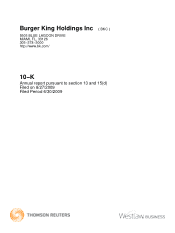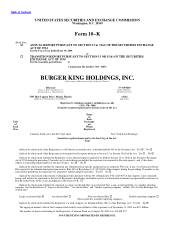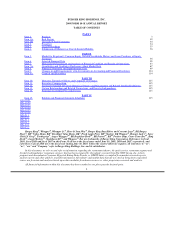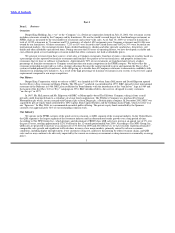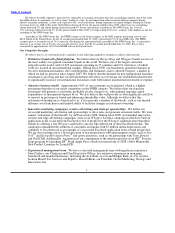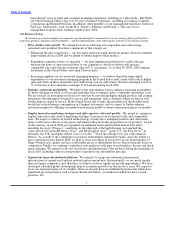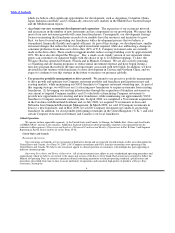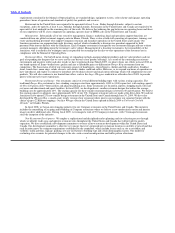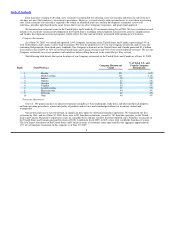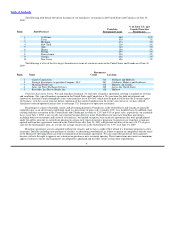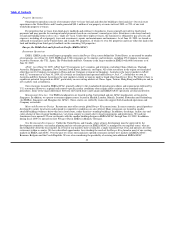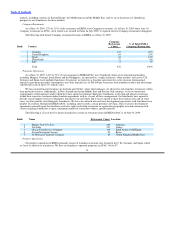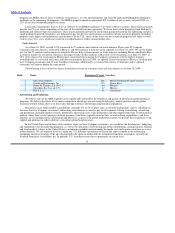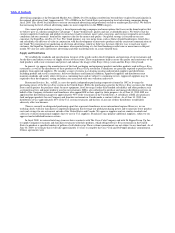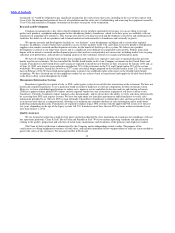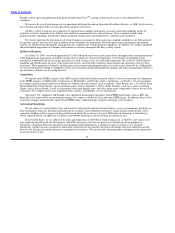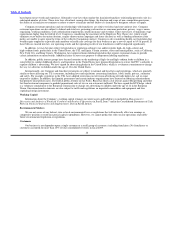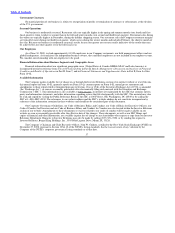Burger King 2009 Annual Report Download - page 9
Download and view the complete annual report
Please find page 9 of the 2009 Burger King annual report below. You can navigate through the pages in the report by either clicking on the pages listed below, or by using the keyword search tool below to find specific information within the annual report.
Table of Contents
requirements contained in the Manual of Operating Data are standard design, equipment system, color scheme and signage, operating
procedures, hours of operation and standards of quality for products and services.
Restaurants in the United States are required to be open until at least 2 a.m., Friday through Saturday, subject to certain
exceptions, and to be open by at least 6 a.m., Monday through Saturday. Restaurants in the United States and Canada are required to be
open until at least midnight on the remaining days of the week. We believe that reducing the gap between our operating hours and those
of our competitors will be a key component in capturing a greater share of FFHR sales in the United States and Canada.
Management. Substantially all of our executive management, finance, marketing, legal and operations support functions are
conducted from our global restaurant support center in Miami, Florida. There is also a field staff consisting of operations, training, real
estate and marketing personnel who support Company restaurant and franchise operations in the United States and Canada. Our
franchise operations are organized into eight divisions, each of which is headed by a division vice president supported by field
personnel who interact directly with the franchisees. Each Company restaurant is managed by one restaurant manager and one to three
assistant managers, depending upon the restaurant’s sales volume. Management of a franchise restaurant is the responsibility of the
franchisee, who is trained in our techniques and is responsible for ensuring that the day−to−day operations of the restaurant are in
compliance with the Manual of Operating Data.
Restaurant Menu. Our barbell menu strategy of expanding our high−margin indulgent products and our value products and our
goal of expanding the dayparts that we serve are the core drivers of our product offerings. As a result of the continuing recessionary
environment and negative traffic and sales trends we have experienced since March 2009, we plan to focus our efforts in fiscal 2010 on
our brand equities of flame−broiled taste, quality and size at affordable prices to differentiate Burger King restaurants from our
competitors. The basic menu of all of our restaurants consists of hamburgers, cheeseburgers, chicken and fish sandwiches, breakfast
items, french fries, onion rings, salads, desserts, soft drinks, shakes, milk and coffee. However, as we expand our hours of operation we
have introduced, and expect to continue to introduce new breakfast, dessert and snack menu offerings which will complement our core
products. We will also continue to use limited time offers, such as the Angry Whopper sandwich we offered in fiscal 2009, to provide
guests with innovative taste experiences.
Restaurant Design and Image. Our restaurants consist of several different building types with various seating capacities. The
traditional Burger King restaurant is free−standing, ranging in size from approximately 1,900 to 4,300 square feet, with seating capacity
of 40 to 120 guests, drive−thru facilities and adjacent parking areas. Some restaurants are located in airports, shopping malls, toll road
rest areas and educational and sports facilities. In fiscal 2005, we developed new, smaller restaurant designs that reduce the average
building costs by approximately 20%. The seating capacity for these smaller restaurant designs is between 40 and 80 guests. We believe
this seating capacity is adequate since approximately 62% of our U.S. Company restaurant sales are made at the drive−thru. We and our
franchisees have opened 251 new smaller design restaurants in the United States and Canada through June 30, 2009. We have also
developed the Whopper Bar, a small−scale, trendy version of our restaurant where guests can customize our signature burger with the
choice of up to 22 different toppings. Our first Whopper Bar in the United States opened in March 2009 at Universal Citywalk
Orlando® in Orlando, Florida.
In fiscal 2008, we began our reimaging initiative for our Company restaurants in the United States and Canada. This initiative
includes the remodeling or scraping and rebuilding of Company restaurants where we believe a new modernized exterior and interior
image can drive additional sales. During fiscal 2009, we reimaged a total of 39 Company restaurants, with 71 reimaged restaurants
since the inception of the initiative.
New Restaurant Development. We employ a sophisticated and disciplined market planning and site selection process through
which we identify trade areas and approve restaurant sites throughout the United States and Canada that will provide for quality
expansion. We have established a development committee to oversee all new restaurant development within the United States and
Canada. Our development committee’s objective is to ensure that every proposed new restaurant location is carefully reviewed and that
each location meets the stringent requirements established by the committee, which include factors such as site accessibility and
visibility, traffic patterns, signage, parking, site size in relation to building type and certain demographic factors. Our model for
evaluating sites accounts for potential changes to the site, such as road reconfiguration and traffic pattern alterations.
7

